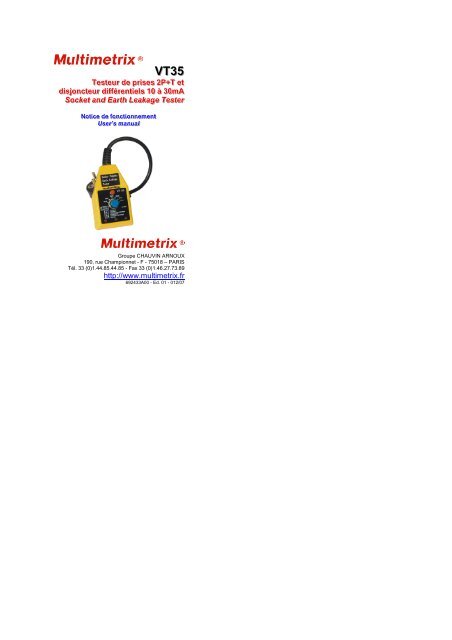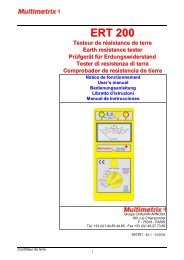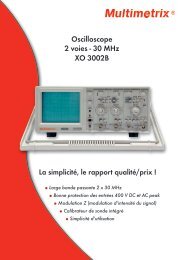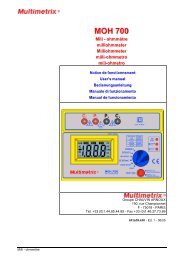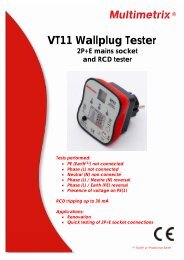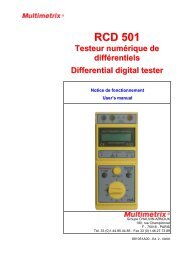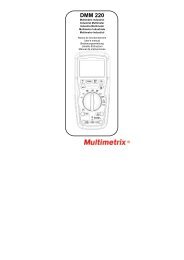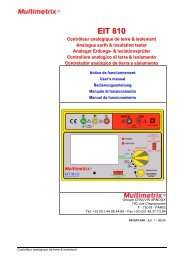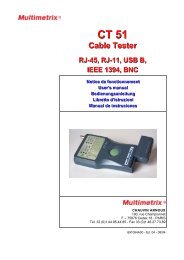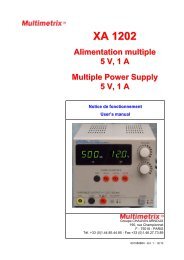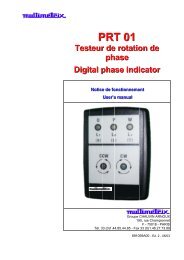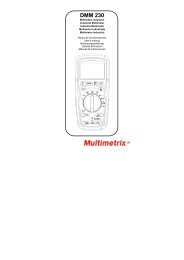TTeesstteeuurr ddee pprriisseess 22PP++TT eett ... - Elfa
TTeesstteeuurr ddee pprriisseess 22PP++TT eett ... - Elfa
TTeesstteeuurr ddee pprriisseess 22PP++TT eett ... - Elfa
Create successful ePaper yourself
Turn your PDF publications into a flip-book with our unique Google optimized e-Paper software.
FrançaisGarantieL'équipement est garanti contre toutdéfaut de matière ou vice defabrication, conformément auxconditions générales de vente.Pendant la période de la garantie (1an), l'instrument ne doit être réparé quepar le fabricant, qui se réserve le droitde choisir entre sa réparation et sonremplacement, en tout ou en partie.En cas de retour de l'équipement aufabricant, les frais de port sont à lacharge du client.La garantie ne s'applique pas suite à :1. utilisation inappropriée del'équipement ou utilisation avec unmatériel incompatible ;2. modifications apportées àl'équipement sans l'autorisationexplicite du service technique dufabricant ;3. travaux effectués sur l'instrumentpar une personne non agréée par lefabricant ;4. adaptation à une applicationparticulière, non prévue par ladéfinition du matériel ou nonindiquée dans la notice defonctionnement ;5. dommages dus à des chocs, à deschutes ou à une immersionprolongée.
FrançaisMaintenance Retournez l'instrument à votredistributeur pour tout travail àeffectuer dans le cadre ou non de lagarantie.Déballage –Ré-emballageL'équipement a été entièrementcontrôlé mécaniquement etélectroniquement avant sonexpédition. Toutes les précautionsnécessaires ont été prises pour quevous receviez l'instrument en bonétat. Il est conseillé de contrôlerrapidement le matériel afin devérifier l'absence de tout dommagequi aurait pu survenir pendant letransport. En cas de dommage,notifiez immédiatement autransporteur les réserves d'usage. Sivous êtes amené à expédierl'instrument sur un autre site, utilisezde préférence son emballaged'origine et indiquez aussiclairement que possible les motifsdu renvoi dans une note jointe àl'équipement.
FrançaisDescription1. Fiche 2P+T2. Bouton de Test3. Sélecteur rotation de courant de défaut
FrançaisMode d’emploiContrôled’une prise2P+T1. Insérer la fiche 2P+T de l’appareildans une prise secteur 10-16AN : NeutreP : PhaseE : Terre2. Contrôler la séquence des lesvoyants néons.3. Si une séquence de défaut estafficher. Corriger le défaut puis faireun nouveau test voyant néon éteint voyant néon allumé☺ OK (absence de défaut)☹ Terre non connectée☹ Phase et Neutre inversés☹ Neutre non connecté☹ Phase et Terre inversées☹ Phase non connectéNota : L’inversion du Neutre (N) et de la Terre (E) nepeut être détectée par le VT35
FrançaisContrôle d’undisjoncteurdifférentiel(≤30mA)1 - Procéder au contrôle de la prise2P+T (voir chapitre précédent) etcorriger éventuellement le défaut2a - Positionner le sélecteur rotatifsur la position 10 mA (courant dedéfaut le plus petit)3a - Procéder au test en appuyantun court instant sur le boutonpoussoir.En l’absence de déclenchement dudisjoncteur différentiel.2b - Augmenter le courant de défauten modifiant la position du sélecteurrotatif (position suivante dans lesens horaire)3b - Procéder à un nouveau test4 - Répéter les étapes 2b et 3bjusqu’à obtenir un déclenchement dudisjoncteur et noter la valeur ducourant ainsi obtenue.5 – Si le déclenchement n’a pu êtreobtenu le disjoncteur est défectueux
EnglishGeneral InstructionsPrecautionsand safetymeasuresThank you for purchasing this VT35tester.The VT35 is used to test TT-earthed2P+E sockets and detect first-faultanomalies in socket connections to theelectrical installation (presumedcompliant).The VT35 is also used to testdifferential circuit breakers up to 30mA.Comply with operating environmentand storage conditions.This hand-held, stand-aloneinstrument has been designed foruse:- indoors;- in Pollution Degree 2environments;- at altitudes of less than2,000m and at temperatures ofbetween 5°C and 40°C.It is suitable for use at up to 230V onCategory II installations.
EnglishDefinition ofInstallationCategories(see IEC 664-1)SymbolsCleaningCAT I: Circuits in which measuresare taken to limit transientovervoltages to an appropriately lowvoltage. E.g. protected electroniccircuits.CAT II: Power supply circuits fordomestic appliances and the likewhich may be subject to mediumleveltransient overvoltages.E.g. household appliances andportable tools.CAT III: Power supply circuits forpower appliances which may besubject to high-level transientovervoltages.E.g. industrial machines or devices.CAT IV: Circuits which may besubject to very high-level transientovervoltages.E.g. power feedersDirective 2002/96/EC (WEEE)Unplug the leads from external circuitsand turn the instrument off. Clean theinstrument with a damp cloth and soap.Never use abrasive products orsolvents.Make sure the instrument is quite drybefore reusing it.
EnglishWarrantyThis equipment is warranted to be freeof defects in materials or workmanship,in accordance with the general termsand conditions of sale.During the one-year warranty period,the instrument may be repaired by themanufacturer only, who reserves theright to either repair it or replace it, infull or in part.In the event the equipment is returnedto the manufacturer, postal charges willbe borne by the customer.The warranty does not apply following:6. misuse of the equipment or use withincompatible equipment;7. modifications to the equipmentwithout the explicit authorisation ofthe manufacturer's TechnicalDepartment;8. work carried out on the instrumentby a person not approved by themanufacturer;9. adaptation for a specific application,not included in the definition of theequipment or the user manual;10. damage caused by knocks, falls orprolonged immersion.
EnglishMaintenance Return the instrument to yourdistributor for any work that has tobe carried out, whether underwarranty or not.Unpacking -RepackingThe instrument was fully checked,mechanically and electronically,before shipping. All necessaryprecautions have been taken toensure you receive the instrument ingood condition. It is advisable tomake a quick check of theequipment to ensure no damage hasoccurred during transportation. Inthe event of damage, immediatelynotify the carrier of the customaryreservations. If you need to send theinstrument to a different site, youshould preferably use its originalpackaging and state your reasonsfor returning it, as clearly aspossible, in a note enclosed with theinstrument.
EnglishDescription4. 2P+E plug5. Test button6. Default current rotary selector switch
EnglishOperating instructionsChecking a2P+E socket4. Insert the device's 2P+E plug intoa 10-16A mains socketN: NeutralP: PhaseE: Earth5. Check the sequence of neonindicators.6. If a fault sequence is displayed,correct the fault then do another test. neon indicator off neon indicator on☺ OK (no fault)☹ Earth not connected☹ Phase and Neutral reversed☹ Neutral not connected☹ Phase and Earth reversed☹ Phase not connectedNote: the VT35 cannot detect a reversed Neutral (N)and Earth (E)
Checking adifferentialcircuit breaker(≤30mA)English1 – Check the 2P+E socket (seeprevious chapter) and correct thefault if necessary2a – Set the rotary selector switch to10mA (the smallest default current)3a – Carry out the test by pressingthe test button briefly.If the differential circuit breaker is notactivated:2b – Increase the default current byturning the rotary selector switchclockwise to the next position3b – Carry out another test4 – Repeat steps 2b and 3b until thecircuit breaker is activated and notethe value of the correspondingcurrent.5 – If the circuit breaker fails toactivate, it is faulty.


